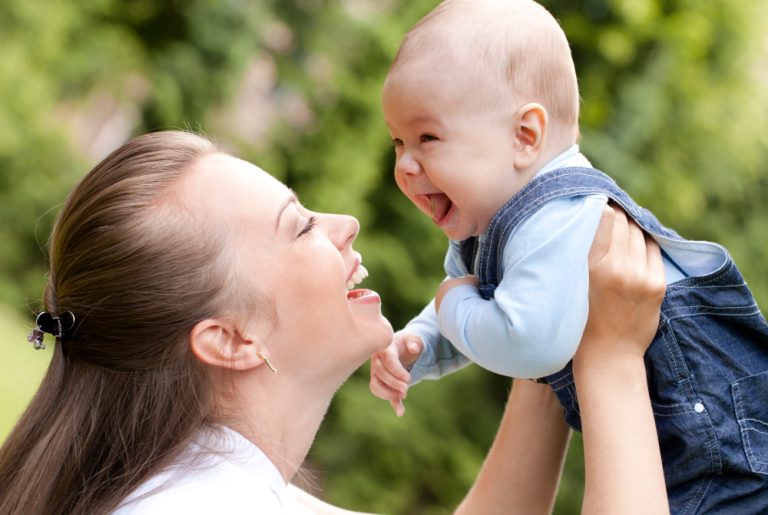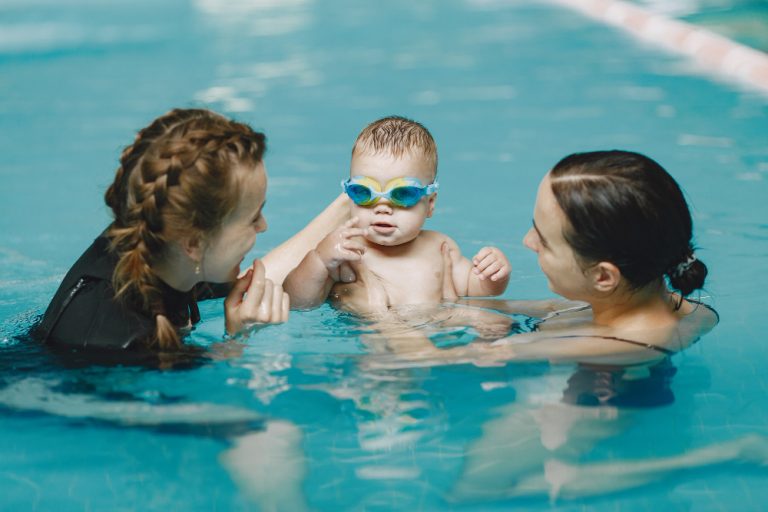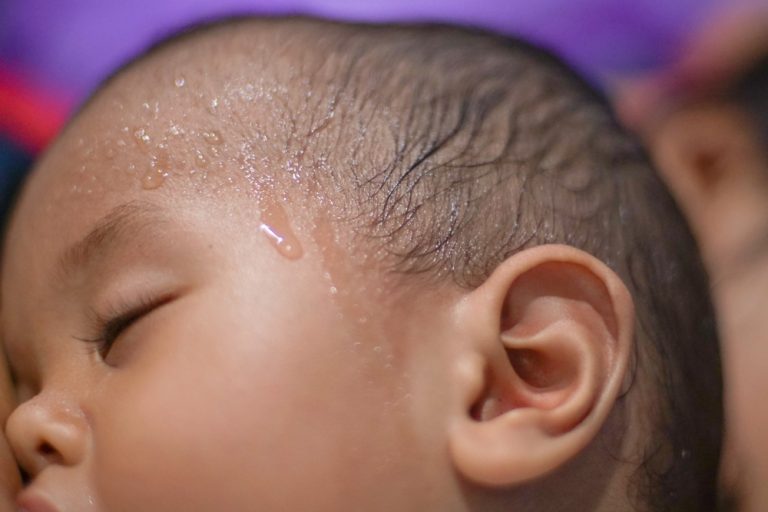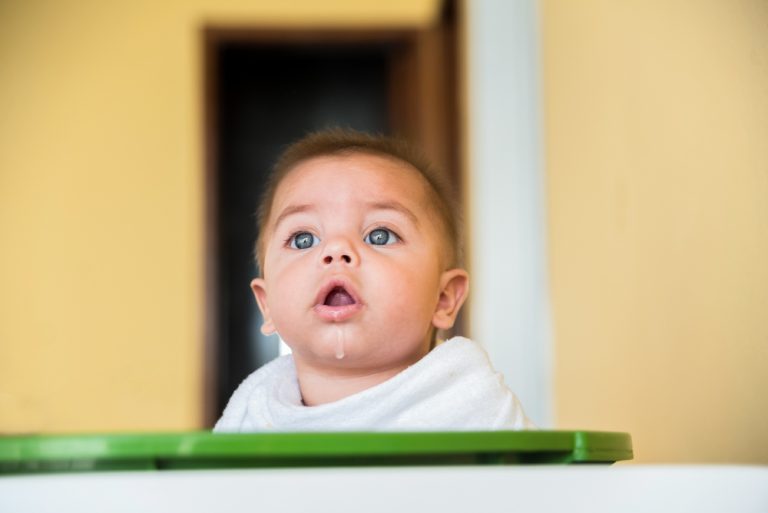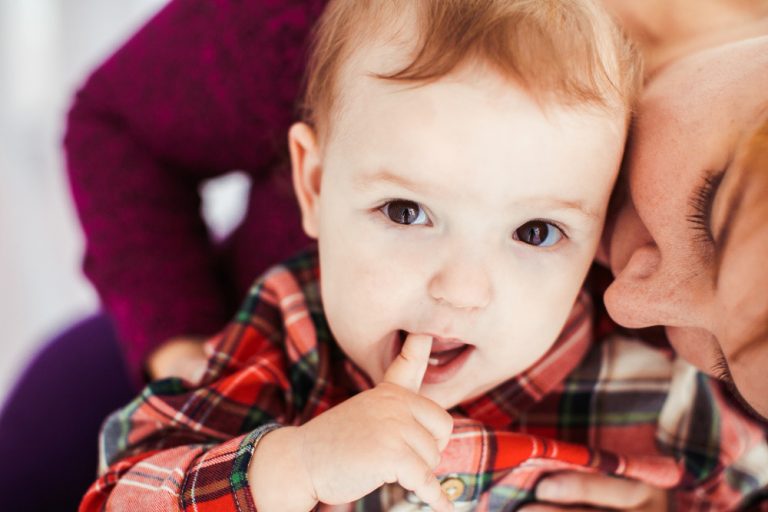What Is The First Sense A Baby Develops? The Sensory Journey
Did you know that the journey of sensory development begins long before a baby is born? Have you ever wondered what is the first sense a baby develops? Imagine a tiny being nestled in the womb, already experiencing the world through the sense of touch. This initial sensation is not just the first to emerge but plays a crucial role in shaping a baby’s perception and interaction with their environment.
As caregivers and parents, understanding the progression of touch as a developing baby’s primary sense is vital. From the delicate receptors in their skin to the intricate neural connections being formed, each stage of touch development is a milestone in their sensory journey. Let’s delve into the fascinating evolution of touch from the womb to early infancy and explore its significance in nurturing a baby’s sensory experiences.
In this blog, we will unravel the captivating nuances of a baby’s sensory world, focusing on the significance of touch as their foundational sense. From the role of touch receptors to the impact of skin-to-skin contact, we’ll uncover practical insights to stimulate and nurture this essential aspect of a baby’s sensory development. Join us on a sensory adventure that celebrates the incredible journey of touch in a developing baby’s life and discover what is the first sense a baby develops?
Your Baby’s Sense of Touch

The sense of touch plays a crucial role in your baby’s sensory development. It is the first sense to develop and forms the foundation for their understanding of the world around them. Through touch, babies explore their environment, build connections with loved ones, and learn about textures, temperatures, and pressure. Understanding the development and importance of this sense can provide valuable insights for parents and caregivers.
From the earliest stages of pregnancy, a network of touch receptors begins to form in the fetus, allowing it to sense stimuli from the womb. This development is influenced by factors such as hormone levels and the amniotic fluid surrounding the baby.
Once born, touch continues to be a vital way for newborns to explore and experience their surroundings. The gentle touch of a parent’s hand or the warmth of their body creates a sense of security and comfort. Skin-to-skin contact, also known as kangaroo care, is especially beneficial for nurturing the bond between parent and baby.
As your baby grows, their sense of touch continues to evolve. From one month to twelve months, they experience important milestones in touch perception and sensitivity. They learn to grasp objects, manipulate toys, and develop a sense of their own bodies.
You can help stimulate your baby’s sense of touch by engaging in activities that involve gentle massages, exposing them to different textures, and encouraging safe exploration. The sense of touch is closely connected to other senses, such as smell and temperature perception, creating a holistic sensory experience for your baby.
Remember, providing a nurturing and stimulating touch experience for your baby is an essential part of their overall sensory development.
What Is The First Sense A Baby Develops?
Babies begin their sensory journey with touch, making it the first sense to develop. This sense plays a crucial role in their early experiences and overall sensory development. Through touch, babies explore and interact with their surroundings, helping them make sense of the world around them. It allows them to bond with caregivers, feel comforted, and establish a sense of security.
Touch also has a profound impact on their emotional and physical development. As they grow, babies continue to refine their sense of touch, enhancing their ability to perceive textures, temperatures, and sensations.
How Does My Baby’s Sense of Touch Develop?
During the early stages of a baby’s life, the sense of touch undergoes a remarkable journey of development. From the womb to early infancy, this crucial sense evolves as babies explore their surroundings and interact with the world. Let’s explore the timeline of a baby’s sensory development related to touch:
In the Womb
Even before birth, the development of touch receptors in a fetus begins. Research suggests that by the middle of the third trimester, certain parts of the somatosensory system start forming, allowing the fetus to respond to touch stimuli. Studies, such as a very small study published by the National Institutes of Health, even suggest that the developing fetus can feel pain. The touch receptors in a baby’s skin are connected to the brain through neural circuitry and the spinal cord, forming the foundation for the sense of touch.
Newborn
Once born, touch takes on a vital role in a newborn baby’s exploration of their surroundings. A light touch on their skin, a gentle stroke, or the warmth of your body can stimulate their sense of touch and provide a sense of security and comfort. Close contact, like kangaroo care, where the baby is held against the parent’s skin, is known to have numerous benefits, including regulating the baby’s heart rate and promoting bonding.
1 Month to 12 Months
As your baby grows, their sense of touch continues to develop. During the first year, they become more aware of sensations and textures. They start to explore objects using their hands and mouth, relying on their sense of touch to gather information about the world around them. Encouraging their sense of touch through safe and supervised exploration helps build neural connections and enhances their cognitive development.
Understanding the developmental timeline of your baby’s sense of touch can help you create a nurturing environment that supports their sensory growth and exploration. By providing opportunities for safe touch experiences and being responsive to your baby’s needs, you can contribute to their overall development and well-being.
Remember to always consult with a healthcare professional for expert advice on your baby’s specific needs.
In the Womb

During fetal development, the sense of touch begins to form even before a baby is born. As early as the first trimester, specialized touch receptors start to develop, setting the foundation for this crucial sensory experience. These touch receptors, known as mechanoreceptors, are sensitive to pressure, temperature, and vibration.
Many factors contribute to the development of touch receptors in the womb. Hormone levels play a significant role, in influencing the growth and maturation of these receptors. Research suggests that higher hormone levels, particularly cortisol and estrogen, can enhance sensory development in the fetus.
The amniotic fluid surrounding the fetus also plays a vital role in touch sensation. This fluid acts as a cushion, allowing the fetus to move and explore their environment. By moving and touching different areas of their body, the developing fetus begins to understand their own physical structure.
Interestingly, studies have shown that babies in the womb can respond to external touch. They can feel the touch of their mother’s hand, sudden changes in pressure, and even gentle vibrations. This early exposure to touch helps establish a neural connection in their developing somatosensory system.
In conclusion, the development of touch receptors in the womb sets the stage for a baby’s sensory experience. Hormone levels and the presence of amniotic fluid play crucial roles in shaping this early sensory system. The sense of touch begins to form before birth, highlighting the importance of providing a nurturing and tactile environment for the developing fetus.
Newborn
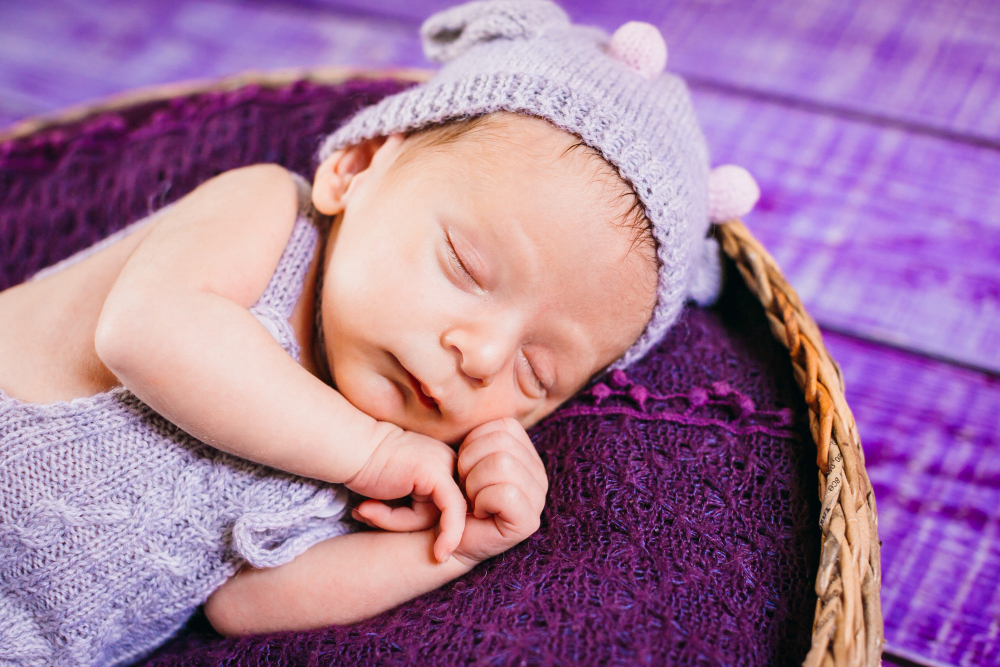
During the newborn stage, touch plays a crucial role in shaping a baby’s understanding of the world around them and fosters their early sensory experiences. From the moment they enter the world, babies are immediately exposed to a myriad of tactile sensations that contribute to their overall development.
1. Exploration and Connection
- Newborns instinctively reach out and grasp objects, using their tiny hands to explore the textures and shapes they encounter.
- Skin-to-skin contact with parents and caregivers promotes bonding and provides a sense of security and comfort.
- Gentle touch and caresses from loving adults create a soothing environment for the baby, regulating their stress levels.
2. Sensory Stimulation
- Soft fabrics, different temperatures, and gentle strokes on their skin stimulate the development of the baby’s sensory receptors.
- A light touch on their face or palm can evoke reflexes and responses, showcasing their developing neural circuitry.
3. Body Awareness
- Through touch, newborns begin to understand the boundaries of their own bodies.
- Exploring their own hands and feeling the pressure of their toes against a surface helps them become aware of their physical presence.
It is essential for parents and caregivers to provide a nurturing environment filled with gentle touches, cuddles, and safe sensory experiences to support the newborn’s sensory development. By assuming touch as a fundamental aspect of their early interactions, caregivers can promote their baby’s overall well-being and sensory exploration.
1 Month to 12 Months
During the first year of a baby’s life, the sense of touch goes through significant development and plays a crucial role in their sensory experience. Here are the key milestones and experiences related to touch perception and sensitivity:
Newborn Reflexes (0-2 months)
In the first few months, newborns exhibit reflexes that involve touch, such as the grasping reflex and the rooting reflex. These reflexes demonstrate the early sensitivity of a baby’s hands and facial area to touch stimuli. Parents can engage in gentle touch experiences with their newborns to stimulate these reflexes and promote sensory exploration.
Skin-to-Skin Contact (0-3 months)
Close contact, especially through skin-to-skin contact, is essential during a baby’s early months. This physical closeness provides warmth, comfort, and a sense of security, creating a strong bond between the baby and caregiver. Numerous studies have shown that skin-to-skin contact can help regulate the baby’s temperature, heart rate, and stress levels.
Sensory Exploration (3-6 months)
Around three to six months, babies begin to actively explore the world through touch. They will reach out, grab objects, and explore their surroundings by mouthing or manipulating objects with their hands. Providing safe and age-appropriate toys that have different textures and shapes can enhance the baby’s tactile experiences and hand-eye coordination.
Tactile Discrimination (6-9 months)
Between six and nine months, babies develop more refined tactile discrimination skills. They can differentiate between different textures, temperatures, and levels of pressure. Sensory activities involving exploration of textured objects, engaging in finger painting, or playing with soft toys can stimulate tactile discrimination development.
Fine Motor Skills (9-12 months)
Toward the end of the first year, babies begin to develop fine motor skills, such as picking up small objects with their thumb and forefinger (pincer grasp). They can imitate gestures like waving or clapping their hands. Encouraging baby-led play with different objects, textures, and shapes further enhances their tactile skills and coordination.
Remember, each baby’s developmental timeline may vary, but providing opportunities for safe and stimulating touch experiences can foster their sensory growth and exploration. By encouraging tactile experiences throughout the first year, you can help support your baby’s overall sensory development.
How Can I Soothe My Baby with Touch?
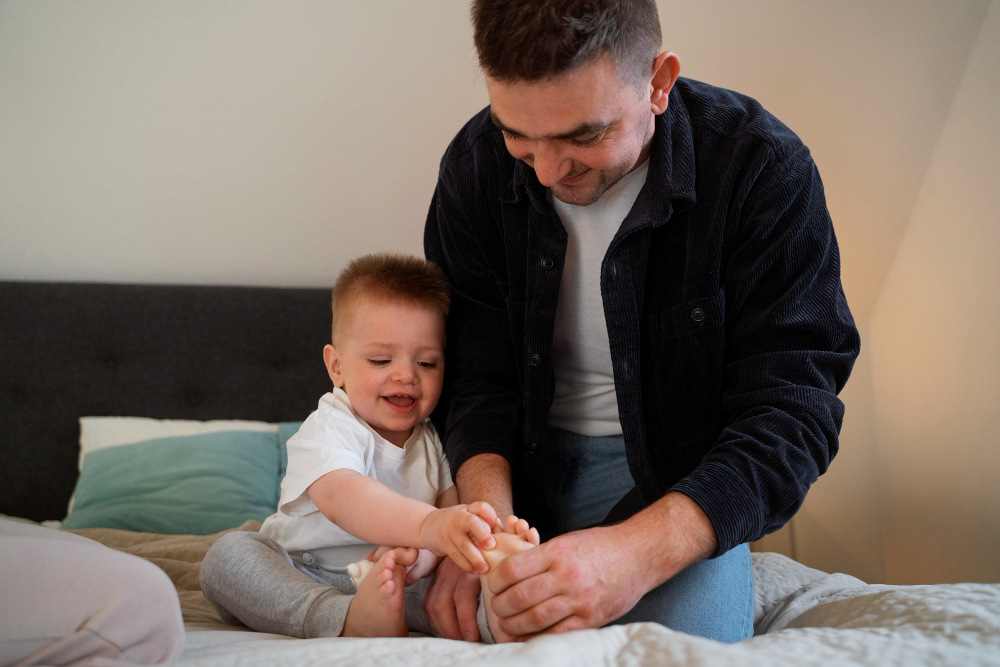
Soothing a baby through touch is a powerful way to provide comfort and nurture their emotional well-being. Skin-to-skin contact, also known as kangaroo care, is particularly beneficial for both newborns and premature babies. It helps regulate their body temperature, heart rate, and breathing, while creating a sense of security and bonding. Here are some practical techniques for soothing your baby with touch:
1. Gentle strokes
Use soft and rhythmic strokes on your baby’s back, arms, or legs to promote relaxation.
2. Massage
Learn simple infant massage techniques to calm your baby’s muscles and promote better sleep.
3. Cuddling
Holding your baby close and offering warmth through your body can create a sense of security and reassurance.
4. Rocking or swaying
Gently rocking or swaying your baby in your arms or a rocking chair can be soothing and comforting.
5. Skin-to-skin contact
Undress your baby and hold them against your bare chest, providing the warmth and closeness they experienced in the womb.
Remember, every baby is unique, so pay attention to their cues and adapt your touch to their preferences.
How to Encourage Your Baby’s Sense of Touch

Encouraging the development of your baby’s sense of touch is an essential aspect of their sensory growth and exploration. Here are some strategies and activities you can incorporate into your daily routine:
1. Skin-to-skin contact
Regularly engage in skin-to-skin contact with your baby, which helps create a strong bond and enhances their tactile experiences.
2. Texture exploration
Offer various textured surfaces for your baby to explore, such as different fabrics or tactile toys. This helps stimulate their sense of touch and develop sensory awareness.
3. Massage and gentle touch
Incorporate gentle massage sessions into your baby’s routine to provide soothing and nurturing touch experiences.
4. Sensory play
Create a sensory play area with items like soft fabrics, feathers, textured balls, or playdough that encourage tactile exploration.
Remember, each baby develops at their own pace, so be patient and observant to understand what types of touch experiences they most enjoy. By fostering their sense of touch, you are contributing to their overall sensory development.
When Do Babies Laugh?
Laughter is an essential part of a baby’s sensory development and emotional expression. It reflects their growing understanding of humor and social interactions. While every baby is different, most infants begin to laugh around 3 to 4 months of age.
At this stage, babies typically respond to stimuli that they find surprising or amusing. They may giggle when tickled, playfully interact with, or observe silly facial expressions. An active sense of touch, combined with auditory and visual stimuli, contributes to a baby’s laughter response.
It’s important for parents and caregivers to create moments of joy and playfulness to encourage laughter in their little ones. Through gentle interactions, such as peek-a-boo games or funny noises, adults can stimulate their baby’s sense of humor and strengthen the parent-child bond.
Remember, laughter not only brings happiness but also supports a baby’s emotional and social development.
Your Baby’s Sense of Smell
Alongside the sense of touch, a baby’s sense of smell plays a crucial role in their overall sensory development. The senses of touch and smell are intimately connected, as both are closely linked to the brain’s limbic system, which is responsible for emotions and memory. When a baby smells something, it triggers responses and associations with past experiences.
From the moment they are born, babies are capable of recognizing the scent of their caregivers, particularly their mothers. This innate ability helps them build a bond and find comfort in familiar smells. Additionally, a baby’s sense of smell is closely tied to their ability to taste, as aromas greatly influence their perception of flavors.
As a parent or caregiver, you can stimulate your baby’s sense of smell by exposing them to different scents in their environment. Incorporate pleasant smells during feeding or bathing routines, such as using scented lotions, oils, or baby products. Introduce them to a variety of aromas, such as fresh fruits, flowers, or spices, as they grow older. These olfactory experiences contribute to their sensory exploration and cognitive development.
Remember to create a safe and pleasant olfactory environment for your baby, as strong or unpleasant smells can be overwhelming. Always choose products that are gentle and suitable for their delicate skin. By nurturing their sense of smell alongside their sense of touch, you can provide a sensory-rich environment that supports their overall development.
Best Baby Wipes
When it comes to caring for your baby’s delicate skin, choosing the right baby wipes is essential. These wipes not only help in maintaining cleanliness but also play a vital role in protecting your little one from irritation and discomfort. Here are some key factors to consider when selecting the best baby wipes for your baby:
1. Gentle and Hypoallergenic
Look for wipes that are specifically designed for sensitive skin and are free from harsh chemicals, fragrances, and dyes. Hypoallergenic wipes ensure that your baby’s skin remains healthy and irritation-free.
2. Soft and Thick
Opt for wipes that are soft and thick enough to provide a gentle cleaning experience. A soft texture helps prevent any roughness or scratching on your baby’s delicate skin.
3. Moisturizing and Soothing
Consider wipes infused with moisturizing ingredients like aloe vera or chamomile to keep your baby’s skin hydrated and nourished. These additives can also contribute to soothing any existing skin irritations.
4. Dermatologically Tested
Choosing wipes that are dermatologically tested ensures that they have undergone rigorous safety evaluations and are suitable for your baby’s delicate skin.
5. Eco-Friendly and Biodegradable
If you’re conscious about the environment, look for wipes that are biodegradable and made from sustainable materials. These wipes help reduce your carbon footprint and contribute to a healthier planet for your baby’s future.
Remember, always perform a patch test before using any new wipes on your baby’s skin, and if you notice any adverse reactions, discontinue use immediately. By selecting the best baby wipes for your little one, you can provide them with the comfortable and gentle care they deserve.
Baby Hearing Development

The sense of hearing plays a significant role in a baby’s overall sensory development. From the moment they are born, babies are exposed to a world filled with sounds, and their ability to perceive and process these sounds gradually improves over time.
During the early stages of development, babies can already recognize familiar voices and sounds they were exposed to in the womb. By the time they are a few months old, they start to turn their heads towards sounds and actively listen to their surroundings. This is an important milestone as it shows their growing auditory processing abilities.
As babies continue to grow, their auditory system becomes more refined, allowing them to distinguish different sounds, including speech patterns and musical tones. They also learn to associate certain sounds with specific objects or events, which contributes to their language development and understanding of the world around them.
To support your baby’s hearing development, it’s essential to provide them with a stimulating auditory environment. This can include talking to them, singing lullabies, playing gentle music, and exposing them to a variety of sounds. Remember to keep the volume at a safe level to protect their delicate ears.
Overall, fostering a rich auditory experience for your baby enhances their overall sensory development and helps them make sense of the world through sound.
The Final Note: What Is The First Sense A Baby Develops?
To sum up, touch is the first sense to develop in a baby and plays a crucial role in their sensory journey. From the earliest stages of pregnancy, a network of touch receptors begins to form in the fetus, allowing them to sense stimuli from the womb. Once born, touch continues to be a vital way for newborns to explore and experience their surroundings.
As babies grow, their sense of touch continues to evolve, enhancing their ability to perceive textures, temperatures, and sensations. It is essential for parents and caregivers to understand the significance of touch in a baby’s development and provide nurturing and stimulating touch experiences to support their overall sensory development. We hope you got the answer to what is the first sense a baby develops is. For a different opinion or query please share a comment below.


